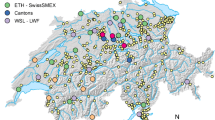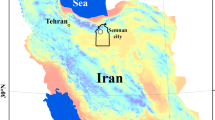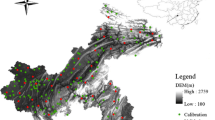Abstract
Rainfall-induced landslides are currently one of the most frequent disasters in China. Compared with rainfall, the increase of soil moisture and its continuous infiltration of soil are the direct factors leading to landslides. However, few researches have studied landslide forecasting taking the soil moisture into consideration. In addition, soil moisture data have an important depth attribute. Soil moisture in root zone is difficult to obtain, and the separate comparison of the impact of the root zone and shallow soil moisture on landslide is more scarce. After comparing the commonly used satellite data, this article chose the CLDAS-V2.0 data set as the source of soil moisture with the depths of 0–10 cm and 100–200 cm. One hundred and sixty-six rainfall-induced landslides that occurred in Tongzi and Xishui counties from February to July 2020 were studied. This paper first obtains the effective rainfall that has the strongest correlation with the landslide and then uses the effective rainfall to explore the best combination of rainfall and soil moisture, including separate modeling and joint modeling of rainfall and soil moisture. Then support vector machine, logistic regression and three decision tree models are developed to predict the landslides. The results show that the combined model of rainfall and soil moisture is better than the model that only considers rainfall or soil moisture, and the landslide forecasting accuracy is improved by more than 5%, which is about 30% higher than the traditional ED rainfall threshold method. Landslide prediction model is proposed to be used as a help for urban planning and government decision-making.












Similar content being viewed by others
References
Abraham MT, Pothuraju D, Satyam N (2019) Rainfall thresholds for prediction of landslides in Idukki, India: an empirical approach. Water 11(10):2113
Abraham MT, Satyam N, Pradhan B, Alamri AM (2020) Forecasting of landslides using rainfall severity and soil wetness: a probabilistic approach for Darjeeling Himalayas. Water 12(3):804
Al-Najjar HA, Kalantar B, Pradhan B, Saeidi V (2019) 'Conditioning factor determination for mapping and prediction of landslide susceptibility using machine learning algorithms. In: Earth resources and environmental remote sensing/GIS applications X. International Society for Optics and Photonics, p 111560K
Beck HE, Pan M, Miralles DG, Reichle RH, Dorigo WA, Hahn S et al (2021) Evaluation of 18 satellite-and model-based soil moisture products using in situ measurements from 826 sensors. Hydrol Earth Syst Sci 25(1):17–40
Bordoni M, Meisina C, Valentino R, Lu N, Bittelli M, Chersich S (2015) Hydrological factors affecting rainfall-induced shallow landslides: from the field monitoring to a simplified slope stability analysis. Eng Geol 193:19–37
Bordoni M, Corradini B, Lucchelli L, Valentino R, Bittelli M, Vivaldi V et al (2019) Empirical and physically based thresholds for the occurrence of shallow landslides in a prone area of Northern Italian Apennines. Water 11(12):2653
Bordoni M, Vivaldi V, Lucchelli L, Ciabatta L, Brocca L, Galve J et al (2021) Development of a data-driven model for spatial and temporal shallow landslide probability of occurrence at catchment scale. Landslides 18(4):1209–1229
Brocca L, Ciabatta L, Moramarco T, Ponziani F, Berni N, Wagner W (2016) Use of satellite soil moisture products for the operational mitigation of landslides risk in Central Italy. Satellite Soil Moisture Retrieval, pp 231–247. https://doi.org/10.1016/b978-0-12-803388-3.00012-7
Brunetti M, Peruccacci S, Rossi M, Luciani S, Valigi D, Guzzetti F (2010) Rainfall thresholds for the possible occurrence of landslides in Italy. Nat Hazard 10(3):447–458
Das NN, Entekhabi D, Dunbar RS, Njoku EG, Yueh SH (2015) Uncertainty estimates in the SMAP combined active–passive downscaled brightness temperature. IEEE Trans Geosci Remote Sens 54(2):640–650
Dong J, Crow WT, Tobin KJ, Cosh MH, Bosch DD, Starks PJ et al (2020) Comparison of microwave remote sensing and land surface modeling for surface soil moisture climatology estimation. Remote Sens Environ 242:111756
Froude MJ, Petley DN (2018) Global fatal landslide occurrence from 2004 to 2016. Nat Hazard 18(8):2161–2181
Gariano SL, Guzzetti F (2016) Landslides in a changing climate. Earth Sci Rev 162:227–252
Godt JW, Baum RL, Lu N (2009) Landsliding in partially saturated materials. Geophys Res Lett 36(2):5996
Guzzetti F, Peruccacci S, Rossi M, Stark CP (2007) Rainfall thresholds for the initiation of landslides in central and southern Europe. Meteorol Atmos Phys 98(3):239–267
Handwerger AL, Huang M-H, Fielding EJ, Booth AM, Bürgmann R (2019) A shift from drought to extreme rainfall drives a stable landslide to catastrophic failure. Sci Rep 9(1):1–12
Huang Y, Zhao L (2018) Review on landslide susceptibility mapping using support vector machines. CATENA 165:520–529
Jackson TJ, Cosh MH, Bindlish R, Starks PJ, Bosch DD, Seyfried M et al (2010) Validation of advanced microwave scanning radiometer soil moisture products. IEEE Trans Geosci Remote Sens 48(12):4256–4272
Keerthi SS, Lin C-J (2003) Asymptotic behaviors of support vector machines with Gaussian kernel. Neural Comput 15(7):1667–1689
Kim S-W, Chun K-W, Kim M-S, Kim M-S, Kim J-H, Lee D-K (2013) Rainfall intensity-duration thresholds for the initiation of a shallow landslide in South Korea. J Korean Soc for Sci 102(3):463–466
Kim K-S, Kim M-I, Lee M-S, Hwang E-S (2020) Regression equations for estimating landslide-triggering factors using soil characteristics. Appl Sci 10(10):3560
Kirschbaum DB, Adler R, Hong Y, Kumar S, Peters-Lidard C, Lerner-Lam A (2012) Advances in landslide nowcasting: evaluation of a global and regional modeling approach. Environ Earth Sci 66(6):1683–1696
Kuradusenge M, Kumaran S, Zennaro M (2020) Rainfall-induced landslide prediction using machine learning models: the case of Ngororero District, Rwanda. Int J Environ Res Public Health 17(11):4147
Lee S, Pradhan B (2007) Landslide hazard mapping at Selangor, Malaysia using frequency ratio and logistic regression models. Landslides 4(1):33–41
Li Q, Wang Z, Shangguan W, Li L, Yao Y, Yu F (2021) Improved daily SMAP satellite soil moisture prediction over China using deep learning model with transfer learning. J Hydrol 600:126698
Lin Q, Wang Y (2018) Spatial and temporal analysis of a fatal landslide inventory in China from 1950 to 2016. Landslides 15(12):2357–2372
Ma Z, Mei G, Piccialli F (2021) Machine learning for landslides prevention: a survey. Neural Comput Appl 33(17):10881–10907
Marino P, Comegna L, Damiano E, Olivares L, Greco R (2020a) Monitoring the hydrological balance of a landslide-prone slope covered by pyroclastic deposits over limestone fractured bedrock. Water 12(12):3309
Marino P, Peres DJ, Cancelliere A, Greco R, Bogaard TA (2020b) Soil moisture information can improve shallow landslide forecasting using the hydrometeorological threshold approach. Landslides 17(9):2041–2054
Moradizadeh M, Srivastava PK (2021) A new model for an improved AMSR2 satellite soil moisture retrieval over agricultural areas. Comput Electron Agric 186:106205
Nahayo L, Mupenzi C, Kayiranga A, Karamage F, Ndayisaba F, Nyesheja EM et al (2017) Early alert and community involvement: approach for disaster risk reduction in Rwanda. Nat Hazards 86(2):505–517
Ozdemir A (2011a) Using a binary logistic regression method and GIS for evaluating and mapping the groundwater spring potential in the Sultan Mountains (Aksehir, Turkey). J Hydrol 405(1–2):123–136
Ozdemir A (2011b) Using a binary logistic regression method and GIS for evaluating and mapping the groundwater spring potential in the Sultan Mountains (Aksehir, Turkey). J Hydrol 405(1–2):123–136
Pecoraro G, Calvello M (2021) Integrating local pore water pressure monitoring in territorial early warning systems for weather-induced landslides. Landslides 18(4):1191–1207
Peruccacci S, Brunetti MT, Gariano SL, Melillo M, Rossi M, Guzzetti F (2017) Rainfall thresholds for possible landslide occurrence in Italy. Geomorphology 290:39–57
Ponziani F, Pandolfo C, Stelluti M, Berni N, Brocca L, Moramarco T (2012) Assessment of rainfall thresholds and soil moisture modeling for operational hydrogeological risk prevention in the Umbria region (central Italy). Landslides 9(2):229–237
Pourghasemi H, Moradi H, Fatemi Aghda S (2013) Landslide susceptibility mapping by binary logistic regression, analytical hierarchy process, and statistical index models and assessment of their performances. Nat Hazards 69(1):749–779
Ran Q, Hong Y, Li W, Gao J (2018) A modelling study of rainfall-induced shallow landslide mechanisms under different rainfall characteristics. J Hydrol 563:790–801
Reichstein M, Camps-Valls G, Stevens B, Jung M, Denzler J, Carvalhais N (2019) Deep learning and process understanding for data-driven Earth system science. Nature 566(7743):195–204
Segoni S, Piciullo L, Gariano SL (2018a) A review of the recent literature on rainfall thresholds for landslide occurrence. Landslides 15(8):1483–1501
Segoni S, Rosi A, Lagomarsino D, Fanti R, Casagli N (2018b) Brief communication: using averaged soil moisture estimates to improve the performances of a regional-scale landslide early warning system. Nat Hazard 18(3):807–812
Spencer M, Wheeler K, White C, West R, Piepmeier J, Hudson D et al. (2010) 'The Soil Moisture Active Passive (SMAP) mission L-band radar/radiometer instrument. In: 2010 IEEE international geoscience and remote sensing symposium. IEEE, pp. 3240–3243
Srivastava S, Anand N, Sharma S, Dhar S, Sinha LK (2020) Monthly rainfall prediction using various machine learning algorithms for early warning of landslide occurrence. In: 2020 International conference for emerging technology (INCET). IEEE, pp 1–7
Tichavský R, Ballesteros-Cánovas JA, Šilhán K, Tolasz R, Stoffel M (2019) Dry spells and extreme precipitation are the main trigger of landslides in Central Europe. Sci Rep 9(1):1–10
Turcato G, Zaboli A, Pfeifer N, Maccagnani A, Tenci A, Giudiceandrea A et al (2021) Decision tree analysis to predict the risk of intracranial haemorrhage after mild traumatic brain injury in patients taking DOACs. Am J Emerg Med 50:388–393
Wagner W, Hahn S, Kidd R, Melzer T, Bartalis Z, Hasenauer S et al (2013) The ASCAT Soil Moisture Product: A Review of its. Meteorol Z 22(1):1–29
Yanna Y, Mo X, Lingmin Z, Qiang Z, Xiaobing K, Bangyan M (2020) Karstic conduits and watershed identification based on the morphological characteristics of depressions in the Yunnan-Guizhou Plateau of China. Environ Earth Sci 79(10):1–12
Yao X, Tham L, Dai F (2008) Landslide susceptibility mapping based on support vector machine: a case study on natural slopes of Hong Kong, China. Geomorphology 101(4):572–582
Zhang Y, Xing A, Jin K, Zhuang Y, Bilal M, Xu S et al (2020) Investigation and dynamic analyses of rockslide-induced debris avalanche in Shuicheng, Guizhou, China. Landslides 17(9):2189–2203
Zhao B, Dai Q, Han D, Dai H, Mao J, Zhuo L (2019) Probabilistic thresholds for landslides warning by integrating soil moisture conditions with rainfall thresholds. J Hydrol 574:276–287
Funding
The authors have not disclosed any funding.
Author information
Authors and Affiliations
Corresponding author
Ethics declarations
Competing interests
The authors have not disclosed any competing interests.
Additional information
Publisher's Note
Springer Nature remains neutral with regard to jurisdictional claims in published maps and institutional affiliations.
Rights and permissions
Springer Nature or its licensor holds exclusive rights to this article under a publishing agreement with the author(s) or other rightsholder(s); author self-archiving of the accepted manuscript version of this article is solely governed by the terms of such publishing agreement and applicable law.
About this article
Cite this article
Guo, Y., Xu, Z., Zhu, S. et al. Using distributed root soil moisture data to enhance the performance of rainfall thresholds for landslide warning. Nat Hazards 115, 1167–1192 (2023). https://doi.org/10.1007/s11069-022-05588-1
Received:
Accepted:
Published:
Issue Date:
DOI: https://doi.org/10.1007/s11069-022-05588-1




